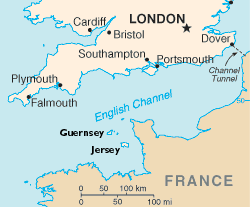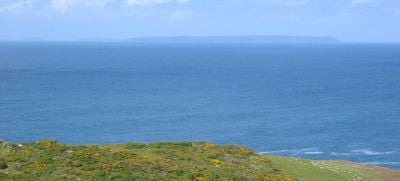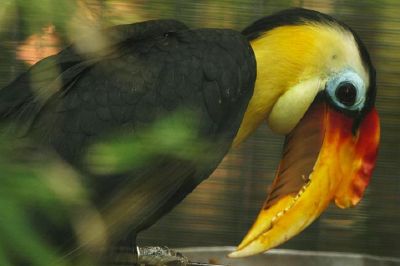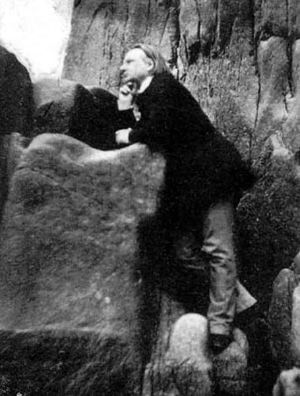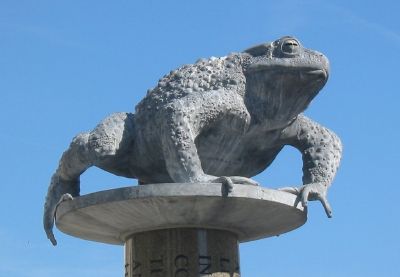Channel Islands
| Native name: Îles Anglo-Normandes Îles d'la Manche | |
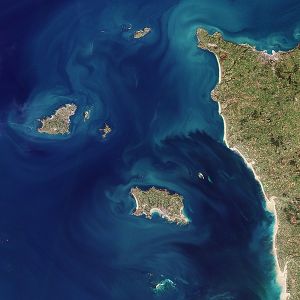 Satellite photo of the Channel Islands in 2018 | |
| Geography | |
|---|---|
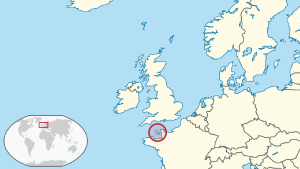 | |
| Location | Northwestern Europe |
| Coordinates | |
| Major islands | Alderney, Guernsey, Jersey, and Sark |
| Area | 198 km² (76 sq mi) |
| Bailiwicks of Guernsey and Jersey | |
| Capital city | Saint Peter Port, Guernsey |
| Capital city | Saint Helier, Jersey |
| Demographics | |
| Population | 177,499 (2022)[1] |
The Channel Islands (Norman: Îles d'la Manche; French: Îles Anglo-Normandes/Îles de la Manche) are a group of islands in the English Channel, off the French coast of Normandy, but dependent on the British Crown. They comprise two separate Bailiwicks: the Bailiwick of Guernsey, which includes Guernsey itself along with Alderney, Sark, Herm, Jethou, Brecqhou, Burhou, Lihou, and the Bailiwick of Jersey, which includes the island of Jersey as well as the islands of the Minquiers, Écréhous, the Pierres de Lecq. The Channel Islands have a total population of about 160,000. The respective capitals, St. Peter Port and St. Helier have populations of 16,488 and 28,310.
These islands represent the last remnants of the medieval Dukedom of Normandy that held sway in both France and England. They were the only British soil occupied by German troops in World War II.
Geography

The inhabited islands of the Channel Islands are Jersey, Guernsey, Alderney, Sark, Herm (the main islands); Jethou, Brecqhou (Brechou), and Lihou.
All of these except Jersey are in the Bailiwick of Guernsey, but the Minquiers, Écréhous, Les Dirouilles and Les Pierres de Lecq (the Paternosters), uninhabited groups of islets, are part of the Bailiwick of Jersey. Burhou and the Casquets lie off Alderney. As a general rule, the larger islands have the -ey suffix, and the smaller ones have the -hou suffix; this is believed to be from the Old Norse ey and holmr, respectively.
The Chausey Islands south of Jersey are not generally included in the geographical definition of the Channel Islands but occasionally described as "French Channel Islands" in English in view of their French jurisdiction. They were historically linked to the Duchy of Normandy, but they are part of the French territory along with continental Normandy, and not part of the British Isles or of the Channel Islands in a political sense. They are an incorporated part of the commune of Granville (Manche), and although popular with visitors from France, are rarely visited by Channel Islanders, as there are no direct transport links from the other islands.
In official Channel Island French, the islands are called Îles de la Manche, while in France, the term Îles anglo-normandes (Anglo-Norman isles) is used to refer to the British Channel Islands in contrast to other islands in the Channel. Chausey is referred to as an Île normande (as opposed to anglo-normande). Îles Normandes and 'Archipel Normand' have also, historically, been used in Channel Island French to refer to the islands as a whole.
The very large tidal variation provides an environmentally rich inter-tidal zone around the islands, and some sites have received Ramsar Convention designation.
The waters surrounding the islands include the following:
- The Swinge (between Alderney and Burhou)
- The Little Swinge (between Burhou and Les Nannels)
- La Déroute (between Jersey and Sark, and Jersey and the Cotentin)
- Le Raz Blanchard, or Race of Alderney (between Alderney and the Cotentin)
- The Great Russel (between Sark, Jéthou and Herm)
- The Little Russel (between Guernsey, Herm and Jéthou)
- Souachehouais (between Le Rigdon and L'Étacq, Jersey)
- Le Gouliot (between Sark and Brecqhou)
- La Percée (between Herm and Jéthou)
The islands, with its mild maritime climate, flowering vegetation and peaceful green scenery have become a popular resort area among continental Europeans. They are well-known for their breeds of cattle and for the export of fruit, flowers, tomatoes, and early potatoes.
Conservation
In 1959 the Jersey Zoological Park opened on the island of Jersey. Naturalist Gerald Durrell founded the park to serve as a wildlife conservation area.[2] Since 1964, the zoo has been home to the Durrell Wildlife Conservation Trust.
Jersey Zoo has always concentrated on rare and endangered species. It has mammals, birds, amphibians and reptiles, comprising over 190 species. The zoo is situated in 31 acres of landscaped parkland and water-gardens. It has a strong commitment to looking after the Island’s native wildlife, and large areas within the grounds have been designated native habitat areas. A £1 million project to redevelop the central valley, completed in 2002, has created a haven for kingfishers, bank voles, butterflies, dragonflies and several species of waterfowl. The extensive planting of flowering and fruiting trees throughout the grounds also serves to attract a plethora of wild birds and insects. Included in the former are several species of bird which were once commonly seen in Island gardens but have become increasingly scarce, including the house sparrow and song thrush.
There are over 50 nest-boxes positioned around the grounds, which are used by a variety of birds including barn owls, kestrels, swallows and martins. Other animals which are commonly seen within the grounds are the red squirrel, bank vole, and the short-toed tree creeper, which is not found in the UK.
Durrell's breeding programs primarily focus on species from locations which are ecologically rich in diversity and not found elsewhere, such as islands and rainforests.
History
The Channel Islands, then called the Lenur Islands, were occupied by the Britons during their migration to Brittany in the fifth to sixth centuries. Various saints such as the Celt Samson of Dol and Branwaldr (Brelade) were active in the region, although tradition has it that it was Saint Helier from Tongeren in modern-day Belgium who brought Christianity to the island in the sixth century, and Charlemagne sent his emissary to the island (then called Angia).
The name for Jersey is sourced to Viking activity in the area between the ninth and tenth centuries: the Norse suffix -ey for island can be found in many places around the northern European coasts. The Channel Islands remained politically linked to Brittany until 933 when William Longsword, Duke of Normandy, seized the Cotentin and the islands. In 1066 Duke William II of Normandy defeated Harold at Hastings to become king of England, although he continued to rule his French possessions as a separate entity.
The dukes of Normandy owned considerable estates on the island, and Norman families living there founded many of the Norman-French Jersey family names. King John lost all his territories in mainland Normandy in 1204 to King Philip II Augustus, but retained possession of Jersey, along with Guernsey and the other Channel Islands. The islands have been self-governing, separate possessions of the Crown.
The Bailiwicks have been administered separately from each other since the late thirteenth century, and although those unacquainted with the islands often assume they form one political unit, common institutions are the exception rather than the rule. The two Bailiwicks have no common laws, no common elections, and no common representative body (although their politicians consult regularly). There is no common newspaper or radio station, but a common television station, ITV Channel Television.
The islands acquired commercial and political interests in the North American colonies. Islanders became involved with the Newfoundland fisheries in the seventeenth century. In recognition for all the help given to him during his exile in Jersey in the 1640s, Charles II gave George Carteret, Bailiff and governor, a large grant of land in the American colonies, which he promptly named New Jersey, now part of the United States of America. Edmund Andros of Guernsey was an early colonial governor in North America, and head of the short-lived Dominion of New England.
During the Second World War, the islands were the only part of the British Commonwealth occupied by Nazi Germany (except a part of Egypt occupied by the Afrika Korps at the time of the Second Battle of El Alamein). The German occupation of the islands, which lasted from 1940–1945, was harsh, with some island residents being taken for slave labor on the continent; native Jews sent to concentration camps; partisan resistance and retribution; accusations of collaboration; and slave labor (primarily Russians and eastern Europeans) being brought to the islands to build fortifications. The Royal Navy blockaded the islands from time to time, particularly following the liberation of mainland Normandy in 1944. Intense negotiations resulted in some Red Cross humanitarian aid, but there was considerable hunger and privation during the five years of German occupation, particularly in the final months when the population was close to starvation.[3] The German troops on the islands surrendered only a few days after the final surrender in mainland Europe.
Politics
The Channel Islands fall into two separate self-governing bailiwicks. Both the Bailiwick of Guernsey and the Bailiwick of Jersey are British Crown Dependencies, but neither is part of the United Kingdom. They have been part of the Duchy of Normandy since the tenth century and Charles III is often referred to by his traditional and conventional title of Duke of Normandy. However, pursuant to the Treaty of Paris (1259) he is not the Duke in a constitutional capacity and instead governs in his right as King. This notwithstanding, it is a matter of local pride by monarchists to treat the situation otherwise; the Loyal Toast at formal dinners is to 'The King, our Duke', rather than 'His Majesty, the King' as in the UK.
The Channel Islands are not represented in the UK Parliament and each island has its own primary legislature, known as the States of Guernsey and the States of Jersey, with Chief Pleas in Sark and the States of Alderney. Laws passed by the States are given Royal Sanction by the Privy Council of the United Kingdom, to which the islands' governments are responsible.
The systems of government date from Norman times, which accounts for the names of the legislatures, the States, derived from the Norman 'États' or 'estates' (i.e. the Crown, the Church, and the people). The States have evolved over the centuries into democratic parliaments.
A bailiwick is a territory administered by a bailiff. The Bailiff in each bailiwick is the civil head, presiding officer of the States, and also head of the judiciary.
In 2001, responsibility for links between the Channel Islands (together with the Isle of Man) and the Crown passed from the Home Secretary to the Lord Chancellor's Department, replaced in 2003 by the Department of Constitutional Affairs.
In addition, Acts of the UK Parliament may be extended to any of the Channel Islands by Order-in-Council (thus giving the UK Government the ultimate responsibility for good governance in the islands). By constitutional convention this is only done at the request of the Insular Authorities, and has become a rare option, the islands usually preferring nowadays to pass localized versions of laws giving effect to international treaties.
Matters reserved to the Crown are limited to defense, citizenship, and diplomatic representation. The islands are not bound by treaties concluded by the United Kingdom (unless they so request) and may separately conclude treaties with foreign governments (except concerning matters reserved to the Crown). The United Kingdom conceded at the end of the twentieth century that the islands may establish direct political (non-diplomatic) contacts with foreign governments to avoid the situation whereby British embassies were obliged to pass on communications from the governments of the Bailiwicks that were in conflict with United Kingdom government policy.
The islands are not part of the European Union, but are part of the Customs Territory of the European Community, by virtue of Protocol Three to the Treaty on European Union.
Islanders are full British citizens, but not all are European citizens. Any British citizen who applies for a passport in Jersey or Guernsey receives a passport bearing the words "British Islands, Bailiwick of Jersey" or "British Islands, Bailiwick of Guernsey." Under the provisions of Protocol Three, Channel Islanders who do not have a close connection with the UK (no parent or grandparent from the UK, and have never been resident in Great Britain or Northern Ireland for any five-year period) do not automatically benefit from the EU provisions on free movement within the EU and consequently their passports receive an endorsement to that effect. This only affects a minority of islanders.
Under the Interpretation Act 1978, the Channel Islands are deemed to be part of the British Islands, not to be confused with the British Isles.
Both Bailiwicks are members of the British-Irish Council, and Jèrriais and Dgèrnésiais are recognized regional languages of the Isles.
The legal courts are separate (separate courts of appeal have been in place since 1961). Among the legal heritage from Norman law is the Clameur de Haro.
Economy
Tourism is the major industry in the smaller islands, along with limited agriculture.
Since the 1960s, Jersey and Guernsey have relied on financial services as offshore financial centers (OFCs). In the last 20 to 25 years, the Channel Islands have blossomed as OFCs due, in part, to their proximity to the United Kingdom, low taxes, and overall economic and political stability. The Islands' financial industry includes banking investment, as well as insurance and trust companies. Total bank deposits on the Islands (both resident and nonresident) currently consist of around £150 billion (Jersey, £100 billion; Guernsey, £50 billion); by comparison, nonresident deposits held in the United Kingdom total approximately £1 trillion. The independence of the Islands also has enabled them to provide considerable tax advantages to their customers. Jersey has the largest banking sector of the Islands, while Guernsey constitutes a major center for captive insurance companies.
Guernsey's horticultural and glasshouse activities have been more significant than in Jersey, and Guernsey has maintained light industry as a higher proportion of its economy than Jersey.
Both Bailiwicks issue their own banknotes and coins, which circulate freely in all the islands alongside UK coinage and Bank of England and Scottish banknotes.
Culture
Culturally, the Norman language predominated in the islands until the nineteenth century, when increasing influence from English-speaking settlers and easier transport links led to Anglicization. There are four main dialects/languages of Norman in the islands, Auregnais (Alderney, extinct in late twentieth century), Dgèrnésiais (Guernsey), Jèrriais (Jersey) and Sercquiais (Sark, an offshoot of Jèrriais).
French writer Victor Hugo spent many years in exile, first in Jersey and then in Guernsey where he wrote Les Misérables. Guernsey is also the setting of Hugo's later novel, Les Travailleurs De La Mer (The Toilers of the Sea). A "Guernsey-man" also makes an appearance in Herman Melville's Moby Dick.
The annual 'Muratti', the inter-island football match, is considered the sporting event of the year, although, thanks to broadcast coverage, it no longer attracts the crowds of spectators traveling between the islands, that occurred during the twentieth century.
Channel Island sportsmen and women compete in the Commonwealth Games for their respective islands, and the islands have been enthusiastic supporters of the Island Games. Shooting is a popular sport—islanders have won Commonwealth medals in this discipline.
Guernsey's traditional color for sporting and other purposes is green and Jersey's is red.
The main islanders have traditional animal nicknames:
- Guernsey: les ânes ('donkeys' in French and Jèrriais); the steepness of St. Peter Port streets required beasts of burden, but Guernsey people also claim it is a symbol of their strength of character. *Jersey: crapauds ('toads' in French and Jèrriais); Jersey has toads and snakes that Guernsey lacks.
- Sark: corbins ('crows' in Sercquiais, Dgèrnésiais and Jèrriais); crows could be seen from sea on the island's coast.
- Alderney: lapins ('rabbits'); The island is noted for its warrens.
Christianity was brought to the islands around the sixth century; according to tradition, Jersey was evangelized by Saint Helier, Guernsey by Saint Samson of Dol and other smaller islands were occupied at various times by monastic communities representing strands of Celtic Christianity. At the Reformation, the islands turned Calvinist under the influence of an influx of French-language pamphlets published in Geneva. Anglicanism was imposed in the seventeenth century, but the Non-Conformist tendency re-emerged with a strong adoption of Methodism. The presence of long-term Catholic communities from France and seasonal workers from Brittany and Normandy added to the mix of denominations among the population.
Other islands in the English Channel
There are other islands in other stretches of the English Channel that are not traditionally included within the grouping of Channel Islands. Among these are Ouessant/Ushant, Bréhat, Île de Batz, and Îles Saint-Marcouf (under French jurisdiction), and the Isle of Wight and the Isles of Scilly (both under UK jurisdiction). However, the Isle of Wight is sometimes considered part of the Channel Islands.
Notes
- ↑ Channel Islands Population Worldometer. Retrieved October 11, 2022.
- ↑ Our Founder Jersey Zoo. Retrieved October 11, 2022.
- ↑ George Forty, Atlantic Wall: Channel Islands: Jersey, Guernsey, Alderney, Sark (Battleground Europe) (Pen and Sword Military, 2008, ISBN 978-0850528589).
ReferencesISBN links support NWE through referral fees
- De Pomerai, Mick, and Andy Robinson. The Rocks and Scenery of Guernsey. St. Peter Port: La Societe Guernesiaise, 2000. ISBN 9780951807521
- Forty, George. Atlantic Wall: Channel Islands: Jersey, Guernsey, Alderney, Sark (Battleground Europe). Pen and Sword Military, 2008. ISBN 978-0850528589
- Peddle, S. V. Pagan Channel Islands: Europe's hidden heritage. London: Robert Hale, 2007. ISBN 0709082487
External links
All links retrieved December 3, 2023.
- States of Alderney
- States of Guernsey
- States of Jersey
- Channel Islands Profile BBC
- About the Channel Islands PwC
- Guernsey The World Factbook
- Jersey The World Factbook
| |||||
Credits
New World Encyclopedia writers and editors rewrote and completed the Wikipedia article in accordance with New World Encyclopedia standards. This article abides by terms of the Creative Commons CC-by-sa 3.0 License (CC-by-sa), which may be used and disseminated with proper attribution. Credit is due under the terms of this license that can reference both the New World Encyclopedia contributors and the selfless volunteer contributors of the Wikimedia Foundation. To cite this article click here for a list of acceptable citing formats.The history of earlier contributions by wikipedians is accessible to researchers here:
The history of this article since it was imported to New World Encyclopedia:
Note: Some restrictions may apply to use of individual images which are separately licensed.
